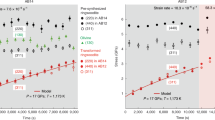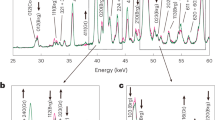Abstract
Seismological observations reveal highly anisotropic patches at the bottom of the Earth's lower mantle, whereas the bulk of the mantle has been observed to be largely isotropic1,2,3,4. These patches have been interpreted to correspond to areas where subduction has taken place in the past or to areas where mantle plumes are upwelling, but the underlying cause for the anisotropy is unknown—both shape-preferred orientation of elastically heterogenous materials5 and lattice-preferred orientation of a homogeneous material6,7,8 have been proposed. Both of these mechanisms imply that large-strain deformation occurs within the anisotropic regions, but the geodynamic implications of the mechanisms differ. Shape-preferred orientation would imply the presence of large elastic (and hence chemical) heterogeneity whereas lattice-preferred orientation requires deformation at high stresses. Here we show, on the basis of numerical modelling incorporating mineral physics of elasticity and development of lattice-preferred orientation, that slab deformation in the deep lower mantle can account for the presence of strong anisotropy in the circum-Pacific region. In this model—where development of the mineral fabric (the alignment of mineral grains) is caused solely by solid-state deformation of chemically homogeneous mantle material—anisotropy is caused by large-strain deformation at high stresses, due to the collision of subducted slabs with the core–mantle boundary.
This is a preview of subscription content, access via your institution
Access options
Subscribe to this journal
Receive 51 print issues and online access
$199.00 per year
only $3.90 per issue
Buy this article
- Purchase on Springer Link
- Instant access to full article PDF
Prices may be subject to local taxes which are calculated during checkout


Similar content being viewed by others
References
Lay, T., Williams, Q. & Garnero, E. J. The core–mantle boundary layer and deep Earth dynamics. Nature 392, 461–468 (1998).
Lay, T., Williams, Q., Garnero, E. J., Kellogg, L. & Wysession, M. E. in The Core-Mantle Boundary (eds Gurnis, M., Wysession, M. E., Knittle, E. & Buffett, B. A.) 299–318 (Geodynamics Series Vol. 28, Am. Geophys. Union, Washington DC, 1998).
Kendall, J. M. in Earth's Deep Interior: Mineral Physics and Tomography from the Atomic to the Global Scale (eds Karato, S., Forte, A. M., Liebermann, R. C., Masters, G. & Stixrude, L.) 133–159 (Geophysics Monograph 117, Am. Geophys. Union, Washington DC, 2000).
Ritsema, J. Evidence for shear velocity anisotropy in the lowermost mantle beneath the Indian Ocean. Geophys. Res. Lett. 27, 1041–1044 (2000).
Kendall, J. M. & Silver, P. G. Constraints from seismic anisotropy on the nature of the lowermost mantle. Nature 381, 409–412 (1996).
Karato, S. Some remarks on the origin of seismic anisotropy in the D″ layer. Earth Planets Space 50, 1019–1028 (1998).
Karato, S. Seismic anisotropy in the deep mantle, boundary layers and the geometry of mantle convection. Pure Appl. Geophys. 151, 565–587 (1998).
Stixrude, L. in The Core-Mantle Boundary (eds Gurnis, M., Wysession, M. E., Knittle, E. & Buffett, B. A.) 83–96 (Geodynamics Series Vol. 28, Am. Geophys. Union, Washington DC, 1998).
McNamara, A. K., Karato, S. & van Keken, P. E. Localization of dislocation creep in the lower mantle: Implications for the origin of seismic anisotropy. Earth Planet. Sci. Lett. 191, 85–99 (2001).
Yamazaki, D. & Karato, S. Some mineral physics constraints on the rheology and geothermal structure of Earth's lower mantle. Am. Mineral. 86, 385–391 (2001).
Frost, H. J. & Ashby, M. F. Deformation Mechanism Maps (Pergamon, Oxford, 1982).
Tackley, P. J. Self-consistent generation of tectonic plates in time-dependent, three-dimensional mantle convection simulations: 1. Pseudoplastic yielding. Geochem. Geophys. Geosys. [online] 〈http://g-cubed.org/〉 1, 2000GC000036 (2000).
Ita, J. & King, S. D. Sensitivity of convection with an endothermic phase change to the form of governing equations, initial conditions, boundary conditions, and equations of state. J. Geophys. Res. 99, 15919–15938 (1994).
Jarvis, G. T. & McKenzie, D. P. Convection in a compressible fluid with infinite Prandtl number. J. Fluid Mech. 96, 515–583 (1980).
Leitch, A. M., Yuen, D. A. & Sewell, G. Mantle convection with internal heating and pressure-dependent thermal expansivity. Earth Planet. Sci. Lett. 102, 213–232 (1991).
Spencer, A. J. M. Continuum Mechanics (Longman, London, 1980).
Ramberg, H. Particle paths, displacement and progressive strain applicable to rocks. Tectonophysics 28, 1–37 (1975).
van Keken, P. E. Cylindrical scaling for dynamical cooling models of the Earth. Phys. Earth Planet. Inter. 124, 119–130 (2001).
Mitrovica, J. X. & Forte, A. M. Radial profile of mantle viscosity: results from the joint inversion of convection and postglacial rebound observables. J. Geophys. Res. 102, 2751–2769 (1997).
Pollack, H. N., Hurter, S. J. & Johnson, J. R. Heat flow from the Earth's interior: analysis of the global data set. Rev. Geophys. 31, 267–280 (1993).
Zhang, S. & Karato, S. Preferred orientation of olivine deformed in simple shear. Nature 375, 774–777 (1995).
Mainprice, D., Barroul, G. & Ben Ismail, W. in Earth's Deep Interior: Mineral Physics and Tomography from the Atomic to the Global Scale (eds Katato, S. et al.) 237–264 (Am. Geophys. Union, Washington DC, 2000).
Yamazaki, D. & Karato, S. Fabric development in (Mg,Fe)O during large strain, shear deformation: Implications for seismic anisotropy in Earth's lower mantle. Phys. Earth Planet. Inter. (in the press).
Karki, B. B. et al. Structure and elasticity of MgO at high pressure. Am. Mineral. 82, 51–60 (1997).
Acknowledgements
We thank M. Gurnis, D. Yamazaki, R. Wenk, T. Lay and B. Kiefer for discussions. This research was supported by the CSEDI program of the National Science Foundation.
Author information
Authors and Affiliations
Corresponding author
Ethics declarations
Competing interests
The authors declare no competing financial interests.
Rights and permissions
About this article
Cite this article
McNamara, A., van Keken, P. & Karato, SI. Development of anisotropic structure in the Earth's lower mantle by solid-state convection. Nature 416, 310–314 (2002). https://doi.org/10.1038/416310a
Received:
Accepted:
Issue Date:
DOI: https://doi.org/10.1038/416310a
This article is cited by
-
Ubiquitous lower-mantle anisotropy beneath subduction zones
Nature Geoscience (2019)
-
Seismic anisotropy of the D″ layer induced by (001) deformation of post-perovskite
Nature Communications (2017)
-
Slab stagnation in the shallow lower mantle linked to an increase in mantle viscosity
Nature Geoscience (2015)
-
Carbon storage at defect sites in mantle mineral analogues
Nature Geoscience (2013)
-
The enigma of post-perovskite anisotropy: deformation versus transformation textures
Physics and Chemistry of Minerals (2011)
Comments
By submitting a comment you agree to abide by our Terms and Community Guidelines. If you find something abusive or that does not comply with our terms or guidelines please flag it as inappropriate.



